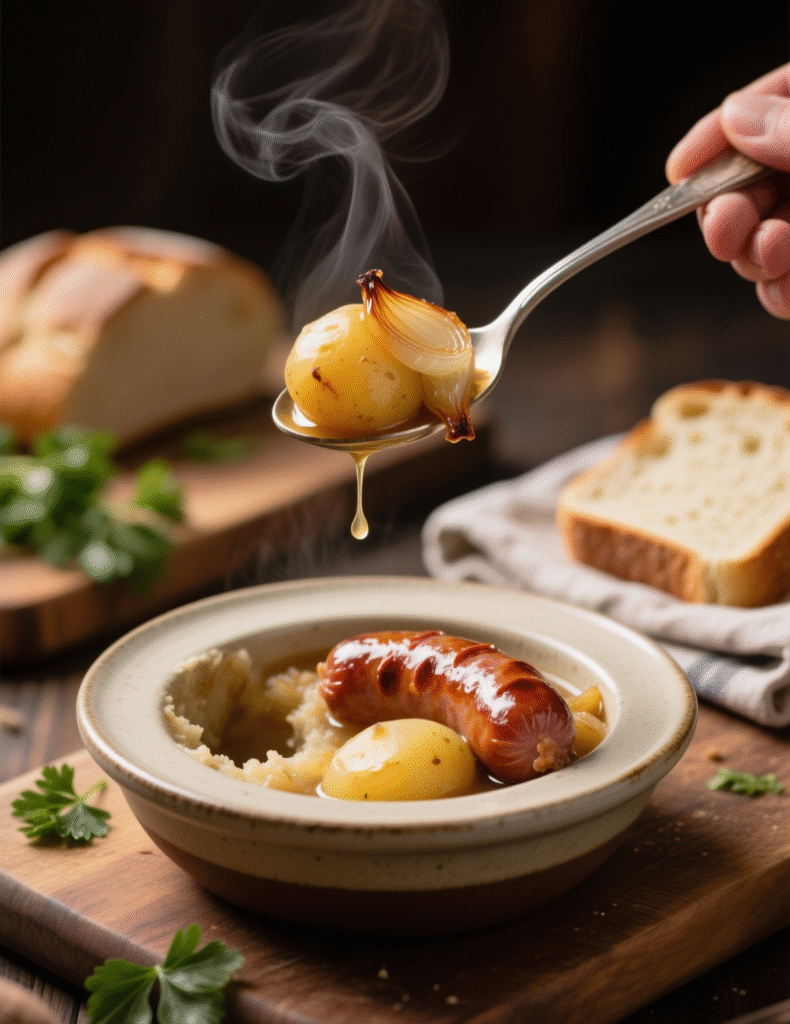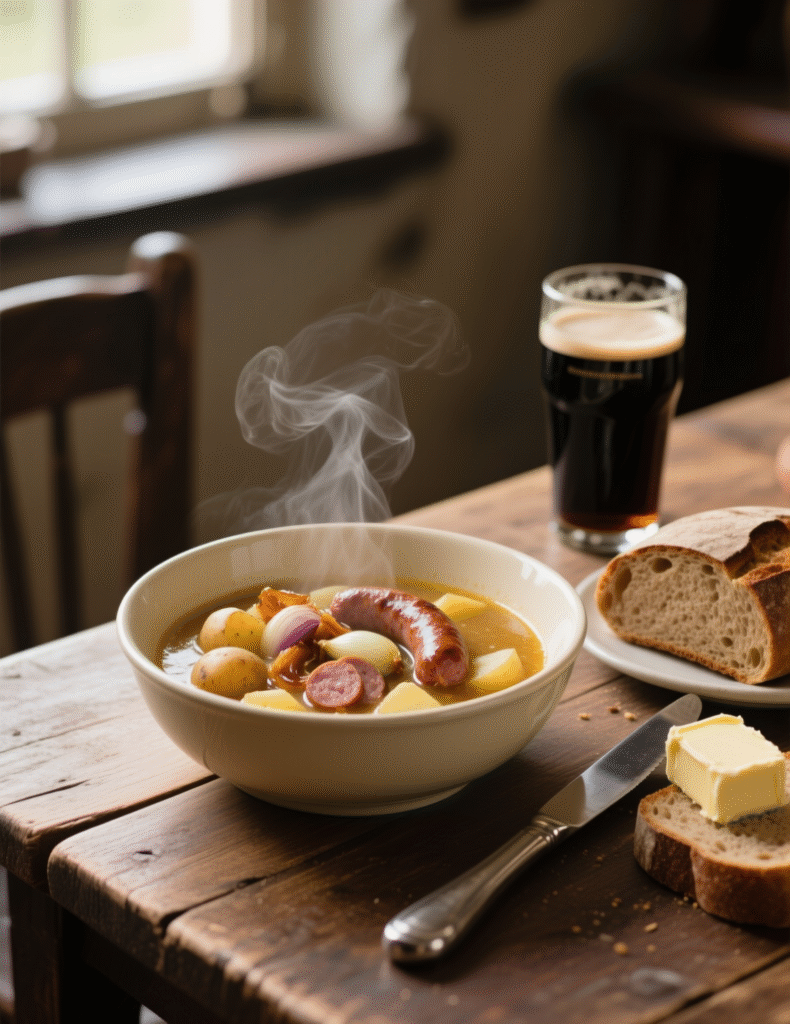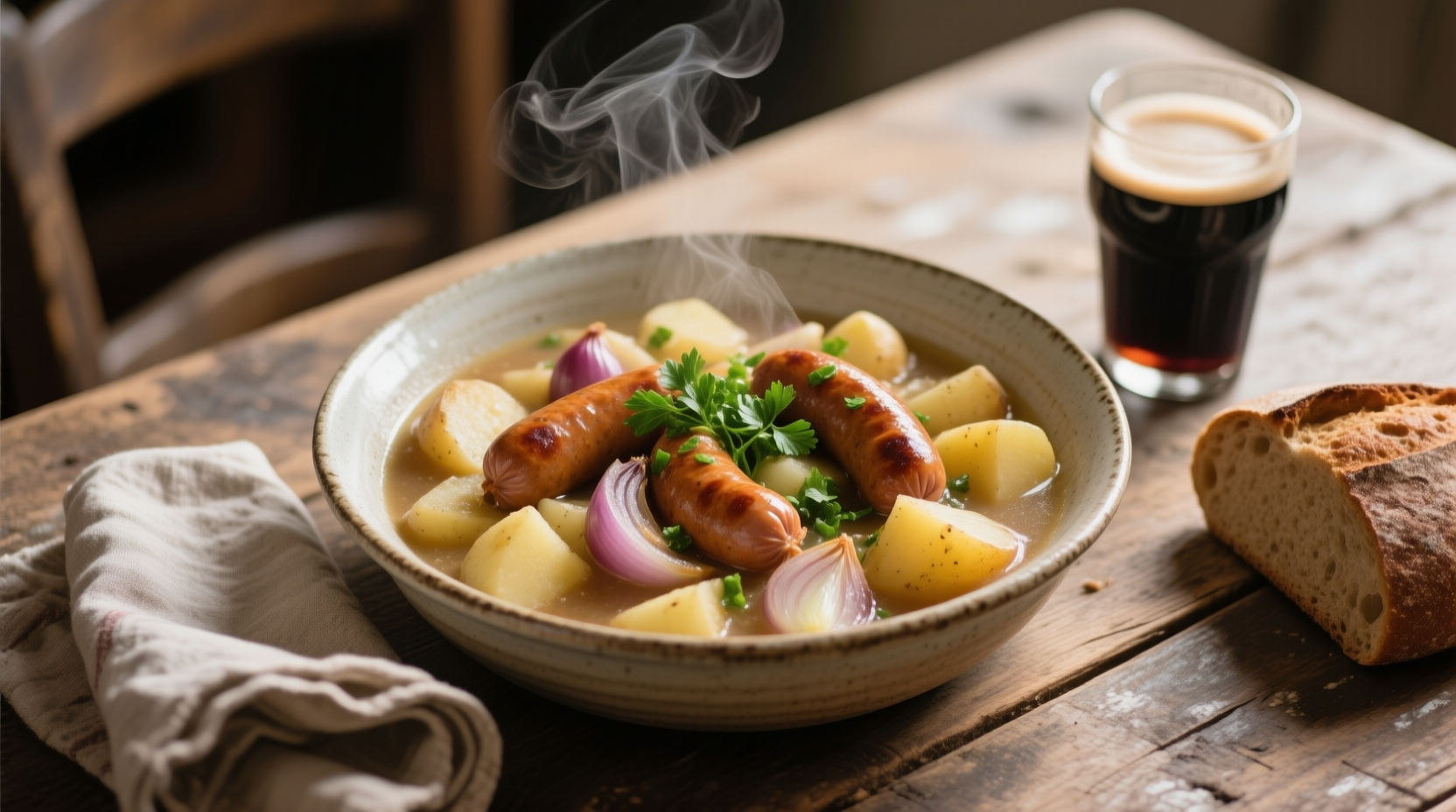Few dishes whisper Dublin’s soul quite like a proper coddle. It’s rustic, humble, and built on scraps that once stretched a poor family’s larder. But don’t let the simplicity fool you. Behind its broth, bacon, and sausage lies a method that rewards patience and technique. My aim here isn’t just to hand you a recipe, but to walk you through its story, its quirks, and the little chef tricks that transform a peasant’s supper into a table centerpiece.
The Origins of Dublin Coddle
Coddle didn’t come from fancy kitchens. It grew from leftovers—bits of sausage, rashers of bacon, potatoes nearing sprout, onions gone soft. Dubliners tossed them into a pot, covered with water or stock, and let it simmer slowly until everything gave up its flavor. This slow simmering, or “coddling,” is what gave the dish its name.
Historically, the coddle was practical. It could sit in a pot for hours while men drank stout at the pub. Families could return home late, still finding it warm and ready. It’s less about timing and more about forgiving slowness. That’s the magic—few dishes allow such relaxed cooking.
What Makes a True Coddle
There’s plenty of debate. Purists insist it must be sausages and rashers only, boiled gently with spuds and onions. Others argue for carrots, herbs, even barley. But at its core, Dublin Coddle isn’t rigid. It reflects what’s on hand. Still, for professionals in the kitchen, there’s a baseline structure worth respecting.
The sausage matters most. In Ireland, pork sausages with a soft bite are traditional. They’re not aggressively seasoned. Bacon is usually thick-cut, salted but not smoky. Potatoes are floury, meaning they break down slightly and lend body to the broth. The onion? It’s not sautéed, not browned—just layered raw, letting sweetness unfold over time.
Choosing the Right Ingredients
Professionals know that ingredient choice separates the good from the unforgettable. You can’t simply throw in generic supermarket sausages and expect greatness. An Irish butcher’s banger is soft, high in pork fat, lightly seasoned with pepper and herbs. If you’re outside Ireland, aim for fresh pork sausages with high meat content. Avoid heavily spiced links.
For bacon, use slab pork belly or thick-cut back bacon. Too much smoke will bully the dish. The fat should render gently, seasoning both broth and potatoes. Potatoes themselves—Russets in the US, Maris Piper or Rooster in Ireland—work beautifully. They soften at the edges, giving that cloudy richness without turning the pot into mush.
Onions should be yellow or brown, not red. Their sweetness deepens with long cooking. And here’s a trick few mention: always slice them thick. Paper-thin onions vanish; thick slices hold shape and offer bite even after hours of stewing.

Broth: Water or Stock?
Tradition leans toward water. Stock was a luxury. But professional kitchens today lean on flavor. A light chicken stock or even a mix of chicken and ham broth provides depth. Avoid beef stock—it’s too strong. A pint of good Irish stout can slip in as well, adding malty bitterness. But careful, too much stout can overwhelm the subtlety.
The coddle’s liquid should never drown the ingredients. Think of it like a braise. Cover just enough so the potatoes steam and the meat bastes itself. By the end, you want a thickened broth clinging to every bite, not a thin soup.
Layering: The Forgotten Technique
Ask any Dublin grandmother, she’ll tell you coddle isn’t stirred. You layer. First bacon, then sausages, then potatoes and onions, repeated like strata of edible geology. The top layer should always be potatoes, so they soak up steam and prevent sausages from drying.
Professional chefs can refine this. Brown sausages lightly beforehand. Some say it’s untraditional, but flavor matters. Render bacon fat gently before layering, letting it coat the pot. Then build your coddle. This method prevents blandness, ensuring every bite carries depth.
Cooking Method: Low and Slow
Coddle isn’t a quick dinner. The entire essence comes from slow heat. Traditionally, it sat in the oven or hearth for 3–4 hours at low temperature. Today, a covered Dutch oven works best. Keep it around 300°F (150°C). If simmering on the stove, keep it at a bare bubble. Vigorous boiling destroys texture and muddles flavor.
Time transforms. After two hours, the broth turns starchy, silky. After three, onions nearly dissolve. Sausages plump but not toughen. Bacon gives up its salt, marrying with potato to create a broth that’s both humble and rich. Patience is rewarded here.
Flavor Builders: Small But Mighty
Salt and pepper are obvious. But parsley, though simple, is a traditional garnish that lifts the whole dish. Some chefs sneak in thyme or bay leaf, and I admit it works. A pinch of mustard powder adds warmth without shouting.
For modern twists, leeks can stand in for onions, lending delicacy. Carrots add color, though old Dubliners roll their eyes at the idea. Even garlic occasionally sneaks in, though it’s not authentic. The point isn’t to police ingredients, but to understand what keeps the dish’s spirit intact—simplicity, slowness, comfort.
Serving Dublin Coddle
Coddle is never served plain. Always with bread. Soda bread or brown bread, thick slices to mop up broth. Butter, lots of it. A pint of Guinness doesn’t hurt either. In restaurants, chefs might plate it with microgreens or serve in cast-iron bowls. But at its heart, coddle wants to be communal. One pot, ladled into deep bowls, bread on the side, laughter in the air.
Nutrition and Practical Value
From a nutritional lens, coddle is heavy but balanced. Potatoes provide starch and fiber. Pork offers protein and fat. Onions add vitamins, and herbs bring antioxidants. For working-class families in 18th- and 19th-century Dublin, it delivered calories and comfort in one pot.
Professionally, it’s a lesson in resourcefulness. Coddle shows how scraps and “cheap cuts” can be elevated with care. That’s a mindset worth teaching in culinary schools—flavor isn’t about luxury, it’s about patience and layering.

Misconceptions About Coddle
One myth is that coddle must be gray and bland. That’s simply poor execution. With good sausages, proper potatoes, and seasoned broth, it sings. Another misconception is that it’s only for cold winters. While true it’s hearty, I’ve seen Dubliners enjoy it in late spring, especially paired with fresh parsley and lighter bread.
Some assume coddle is “just Irish stew.” But no—Irish stew uses lamb or mutton, root vegetables, and a clear broth. Coddle is pork-driven, with sausages and bacon defining its identity. They share the comfort-food DNA, but the soul is different.
Dublin Coddle Recipe (Professional Method)
Ingredients (serves 6):
- 2 lbs Irish pork sausages (or fresh pork sausages)
- 1 lb thick-cut bacon, diced
- 3 large onions, thickly sliced
- 6 medium potatoes, peeled and thickly sliced
- 4 cups light chicken stock (or water)
- 2 bay leaves
- 1 tsp black pepper, freshly cracked
- Small bunch fresh parsley, chopped
- Optional: ½ pint Guinness stout
Method:
- Preheat oven to 300°F (150°C).
- Brown sausages lightly in a skillet for flavor. Set aside.
- In a Dutch oven, render bacon slowly until fat releases. Remove bacon but keep fat in pot.
- Begin layering: bacon, sausages, onions, potatoes. Repeat until ingredients are used, finishing with potatoes on top.
- Season with pepper between layers. Add bay leaves.
- Pour stock (and stout if using) over ingredients—liquid should barely cover.
- Cover pot with lid. Cook in oven for 3 hours, checking occasionally. Add splash of water if drying.
- Remove bay leaves. Adjust seasoning. Scatter parsley before serving.
Variations Across Ireland
Though Dublin owns the coddle, rural variations exist. Some include carrots, others toss in pearl barley for thickness. In Cork, cooks sometimes add cabbage near the end. Modern chefs even replace sausages with black pudding slices. Each version tweaks tradition, but the essence—potatoes, pork, patience—remains.
Why Professionals Should Care
Coddle isn’t just old Dublin nostalgia. It teaches key lessons: layering as flavor strategy, slow moist cooking, respect for humble ingredients. It’s a showcase of how culture shapes cuisine. For chefs designing menus, it offers a hearty, authentic dish that resonates with diners seeking comfort. And for culinary historians, it’s living proof of Ireland’s ingenuity during leaner times.
Conclusion
Dublin Coddle isn’t beautiful to look at. It doesn’t parade like a French terrine or glitter like sushi. Yet, its charm lies deeper. It’s a dish that rewards patience, honors thrift, and connects people to Ireland’s working-class roots. Professionals who master coddle don’t just cook—they understand history simmered in a pot.
When you serve coddle, you’re offering more than sausages and spuds. You’re serving Dublin itself, slow-cooked, humble, and quietly proud.
FAQs
What is Dublin Coddle?
It’s a traditional Irish one-pot dish of sausages, bacon, potatoes, and onions simmered slowly.
Why is it called coddle?
The name comes from “coddling,” meaning slow gentle cooking or simmering.
What sausages work best in Dublin Coddle?
Irish pork sausages or fresh pork sausages with high meat content and mild seasoning.
Can I use smoked bacon?
Lightly salted thick-cut bacon works better than smoked, which can overpower the dish.
Should I use stock or water?
Traditionally water, but light chicken or ham stock adds richer flavor.
Do I need to brown the sausages first?
Purists don’t, but browning adds depth and prevents blandness.
Can vegetables other than potatoes and onions be added?
Yes, some add carrots, leeks, or even barley, though not strictly traditional.
How long does Dublin Coddle cook?
About 3 hours on low heat for best flavor and texture.
What’s the difference between coddle and Irish stew?
Coddle uses pork sausages and bacon, while Irish stew uses lamb or mutton.
What do you serve with Dublin Coddle?
Always bread—soda bread or brown bread for soaking the broth.
Can I make Dublin Coddle ahead of time?
Yes, it reheats well and flavors deepen overnight.
Is Guinness necessary in coddle?
No, it’s optional but adds malty richness if used sparingly.
Can I freeze Dublin Coddle?
Yes, but potatoes may soften too much, so freezing isn’t ideal.
Is Dublin Coddle healthy?
It’s hearty and filling, offering protein, carbs, and comfort in one pot.
Why is layering important in coddle?
Layering ensures even cooking and prevents sausages from drying out.

Mariana is a passionate home cook who creates delicious, easy-to-follow recipes for busy people. From energizing breakfasts to satisfying dinners and indulgent desserts, her dishes are designed to fuel both your body and hustle.
When she’s not in the kitchen, she’s exploring new flavors and dreaming up her next recipe to share with the Foodie Hustle community.

